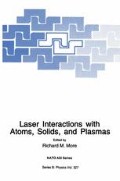Abstract
Atomic electrons subject to intense laser fields can absorb many photons, leading either to multiphoton ionization or the emission of a single, energetic photon which can be a high multiple of the laser frequency. The latter process, high-order harmonic generation, has been observed experimentally using a range of laser wavelengths and intensities over the past several years.1»2 Harmonic generation spectra have a generic form: a steep decline for the low order harmonics, followed by a plateau extending to high harmonic order, and finally an abrupt cutoff beyond which no harmonics are discernible. During the plateau the harmonic production is a very weak function of the process order. Harmonic generation is a promising source of coherent, tunable radiation in the XUV to soft X-ray range which could have a variety of scientific and possibly technological applications. Its conversion from an interesting multiphoton phenomenon to a useful laboratory radiation source requires a complete understanding of both its microscopic and macroscopic aspects. By “microscopic” we mean the response a single atom to a pulse of intense laser radiation, while “macroscopic” refers to the spatial and temporal characteristics of the emitted radiation as it propagates through the nonlinear medium in which it is produced. In this article we focus on the response of a single atom to an intense, short pulse laser. The macroscopic aspects of harmonic generation are treated in detail elsewhere in this volume.3
Access this chapter
Tax calculation will be finalised at checkout
Purchases are for personal use only
Preview
Unable to display preview. Download preview PDF.
References
X.F. Li, A. L’Huillier, M. Ferray, L.A. Lompre and G. Mainfray, Multiple-harmonic generation in rare gases at ligh laser intensity, Phys. Rev. A 39:5751 (1989);
Ph. Balcou, C. Cornaggia, A.S.L. Gomes, L.A. Lompre and A. L’Huillier, Optimizing high-order harmonic generation in strong fields, J. Phys. B 25:4467 (1992).
A. L’Huillier, K.J. Schafer and K.C. Kulander, Theoretical aspects of intense field harmonic generation, J. Phys. B 24:3315 (1991).
L.A. Lompre’, Harmonic generation in atoms, in: “Laser Interaction with Atoms, Solids and Plasma,” R. More, ed., Plenum, New York, (1993).
A. L’Huillier, Ph. Balcou, S. Candel, K.J. Schäfer, and K.C. Kulander, Calculations of high order harmonic generation processes in xenon at 1064 nm, Phys. Rev. A 46:2778 (1992).
A. McPherson, G. Gibson, H. Jara, U. Johann, T.S. Luk, I. Mclntyre, K. Boyer and CK. Rhodes, Studies of multiphoton vacuum-ultraviolet radiation in rare gases, J. Opt. Soc. Am. B 4:595 (1987).
A. L’Huillier and Ph. Balcou, High-order harmonic generation in rare gases with a 1 ps 1053-nm laser, Phys. Rev. Lett. 70:774 (1993).
J.J. Macklin, J.D. Kemetic, and C.L. Gordon, High-order harmonic generation using intense femtosecond pulses, Phys. Rev. Lett. 70:766 (1993).
K. Miyazaki and H. Sakai, High-order harmonic generation in rare gases with intense subpicosecond dye laser pulses, J. Phys. B 25:L83 (1992).
J.K. Crane, M.D. Perry, S. Herman and R.W. Falcone, High field harmonic generation in helium, Optics Letters 18:1256 (1992).
N. Sarukura, K. Hara, T. Adachi, R. Nodormi, M. Watanabe and S. Watanabe, Coherent soft x-ray generation by harmonics of an ultrahigh-power KrF laser, Phys. Rev. A 43:1669(1991).
J.L. Krause, K.J. Schafer, and K.C. Kulander, Calculation of photoemission from atoms subject to intense laser fields, Phys. Rev. A 45:4998 (1992).
K.C. Kulander, K.J. Schäfer and J.L. Krause, Time dependent numerical studies of multiphoton processes, in: “Atoms in Intense Radiation Fields,” M. Gavrila, ed., Advances in Atomic, Molecular and Optical Physics, Supplement 1, Academic Press, New York (1992).
K.C. Kulander and T.C. Rescigno, Effective potentials for time-dependent calculations of multiphoton processes in atoms, Com. Phys. Comm. 63:523 (1991).
K.C. Kulander, Time-dependent Hartree Fock theory of multiphoton ionization: Helium, Phys. Rev. A 36:2726 (1987);
K.C. Kulander, Time dependent theory of multiphoton ionization of xenon, Phys. Rev. A 38:778 (1988).
A. L’Huillier, K.J. Schafer, and K.C. Kulander, High order harmonic generation in xenon at 1064 nm: The role of phase matching, Phys. Rev. Lett. 66:2200 (1991).
K.C. Kulander and B.W. Shore, Calculations of multiple-harmonic conversion of 1064 nm radiation in Xe, Phys. Rev. Lett. 62:524 (1989).
J.L. Krause, K.J. Schafer, and K.C. Kulander, High-order harmonic generation from atoms and ions in the high intensity regime, Phys. Rev. Lett., 68:3535 (1992).
J. Javanainen, J.H. Eberly and Q. Su, Numerical simulations of multiphoton ionization and above-threshold electron spectra, Phys. Rev. A 38:3430 (1988).
This fact, at first known only via numerical solutions, has been demonstrated analytically. See: W.C. Liu and C.W. Clark, Closed-form solutions of the Schrodinger equation for a model one-dimensional hydrogen atom, J. Phys. B 25:L517 (1992).
K.J. Schäfer, J.L. Krause, and K.C. Kulander, Intense laser-induced nonlinear effects in electron and photon emission from atoms, Int. J. Nonlinear Optical Physics 1:245 (1992).
J.H. Eberly, Q. Su and J. Javanainen, Nonlinear light scattering accompanying multiphoton ionization, Phys. Rev. Lett. 62:881 (1989).
H.B. van Linden van den Heuvell and H.G. Muller, Limiting cases of excess-photon ionization, in: “Multiphoton Processes,” S.J. Smith and P.L. Knight, eds., Cambridge University Press, Cambridge (1988).
T.F. Gallagher, Above-threshold ionization in low-frequency limit, Phys. Rev. Lett. 61:2304(1988).
P.B. Corkum, N.H. Burnett and F. Brunei, Above-threshold ionization in the long-wavelength limit, Phys. Rev. Lett. 62:1259 (1989).
Subsequent study of the classical trajectories has shown that the quasiclassical model does provide a convincing explanation of the harmonic plateau and cutoff. See: K.J. Schafer, K.C. Kulander and J.L. Krause, Classical model for high harmonic cutoff, Phys. Rev. Lett, submitted (1993).
Author information
Authors and Affiliations
Editor information
Editors and Affiliations
Rights and permissions
Copyright information
© 1994 Springer Science+Business Media New York
About this chapter
Cite this chapter
Schafer, K.J., Krause, J.L., Kulander, K.C. (1994). Harmonic Generation at High Intensities. In: More, R.M. (eds) Laser Interactions with Atoms, Solids and Plasmas. NATO ASI Series, vol 327. Springer, Boston, MA. https://doi.org/10.1007/978-1-4899-1576-4_4
Download citation
DOI: https://doi.org/10.1007/978-1-4899-1576-4_4
Publisher Name: Springer, Boston, MA
Print ISBN: 978-1-4899-1578-8
Online ISBN: 978-1-4899-1576-4
eBook Packages: Springer Book Archive

